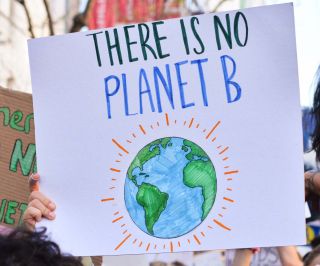Environment
Healthy Responses to Climate Change and Climate Anxiety
When do normal concerns about climate change become climate anxiety?
Posted August 5, 2023 Reviewed by Ray Parker
Key points
- It's getting hot in here, and out there.
- Climate change is manifesting in people's daily lives, eliciting symptoms of anxiety, dread, and panic.
- People choose very different ways of coping with the ongoing climate emergency.

Triple-digit temperatures for weeks on end. Ocean water off the coast of Florida reaching 100 degrees, threatening the bleaching of coral reefs.
Fires running wild in the U.S., Canada, and Europe resulting in orange skies out of a dystopian sci-fi movie. July 2023 was the hottest month on record.
These are facts that demonstrate how climate change is manifesting in people's daily lives, eliciting symptoms of anxiety and dread. When do normal concerns about the impacts of climate change become something else—climate anxiety?
Davenport (2017) writes how our concerns or worries about what’s happening to our planet are healthy and normal reactions to real risks and threats that are clearer and more palpable with each passing year. If climate anxiety starts to interfere with one’s functioning—say, the ability to work, socialize, or enjoy life in general—then it becomes a challenge requiring a solution.
Climate Anxiety: When Concern Becomes Distress
Palpitations, depression, intrusive thoughts, and panic attacks are indications of severe distress and must be taken seriously. Suffering alone is scary. One thing people can do is talk about their thoughts and feelings with others, not only with trained helping professionals but with persons who share their concerns and will really listen.

But allow me to flip the script for a moment, because there are other ways of “thinking” and feeling about climate change. For example, if someone is not worried about climate change, they’re not paying attention.
Different Ways We Can Think About Climate Change
Or if they believe climate change is a hoax (i.e., they’re choosing to ignore basic scientific facts and clear data trends), then they are out of touch with reality. Some adopt a defeatist position of "It’s too late" and "we’re all doomed, or screwed."
Others welcome the end as a fulfillment of religious texts’ apocalyptic prophecies. But when one critically thinks about and engages with what is really happening to our planet, it brings a visceral, frightening reality into tight focus: We are systematically making it ever more difficult, even impossible, for millions of other species, as well as our own, to survive.
What people find incapacitating is an overwhelming fear and a sense of helplessness. In the journal Sustainability, Stevenson and Peterson (2016) asserted that while fear-based messaging can promote behavioral changes, it could also backfire "when individuals perceive low levels of agency or control" (p. 2).
Without hope, fear takes over, and persons who "perceive climate change as out of their control or fail to see how they can make a meaningful difference ... may cope with feelings of fear by denying that there is anything to be concerned about or conclude that attempts to build concern are manipulation instead of education" (p. 2).
Unfortunately, a significant percentage of persons on this planet believe it is flat, that science cannot be trusted, and climate change isn’t real. This fact is frightening, depressing, and disappointing in and of itself.
But resist hopelessness.
Climate scientists want folks to pay attention, feel a sense of urgency and responsibility, and go out and do something, like eating less red meat and voting for persons who subscribe to climate science and do not engage in endless equivocation and bloviation. If we want to see action, we need to avoid shutting people down by:
- sticking closely to what we actually know right now rather than worst-case scenarios
- inviting folks to consider daily, achievable actions that can make a difference
How to Resist Hopelessness and Take Action
Consider taking action. There are ways to become part of solutions to the current climate emergency. Vote for people who support renewable energy projects and initiatives, and vote out politicians who accept campaign donations from fossil fuel entities and who argue that scientists and environmentalists “don’t know what they’re talking about” (because they most certainly do).
People concerned and worried about climate change can vote with their feet by buying an electric car. For instance, the Bolt and the Leaf can be purchased for $27,000 or $29,000, respectively; electric vehicles are quiet, don’t spew pollutants, and many qualify for a hefty tax break.
There are a lot of things people can do, but denial, shrugging, or handwringing to the point of overwhelm and incapacitation are not healthy, responsible, or effective.
Finally, many hands make for lighter work: Community organizing and political action are also social activities, and working shoulder to shoulder on a team, it’s harder to feel isolated, desperate, and alone.
After all, we are all here together on Planet A, and there is no Planet B.
References
Davenport, L. (2019). Emotional resiliency in the era of climate change. Jessica Kingsley Pub.
Stevenson, K., & Peterson, N. (2016). Motivating action through fostering climate change hope and concern and avoiding despair among adolescents. Sustainability, 8(6), 1–10. https://www.mdpi.com/2071-1050/8/1/6/pdf




